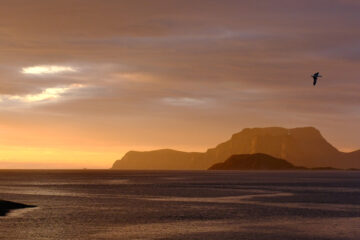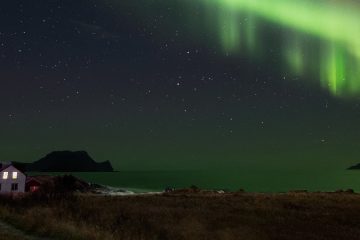If I were Odin I would holiday in the Lofoten, but my own private Asgard would be in Senja.
The beauty of the Lofoten islands and the excellent marketing work of its business-oriented inhabitants give most travelers the impression that Norway, for all practical purposes, ends there. Most boats which arrived here, admittedly a long way off everywhere else, just call it a day and sail back. Few keep going, and are wonderfully rewarded. The same Norwegians appear indeed to inhabit the northern region more happily, and I can understand them. To set up base sandwiched between daunting rock walls and capricious waves requires stamina and a truly challenging spirit. So why not settle islands with a more morbid profile and quieter seas? The different sea routes between Skrova and Tromso are therefore littered by villages and the houses, instead of being hidden behind the hills to shelter family life from wind and spray, are happily raised by the channels with inviting gardens and pleasant docks which testify a far less turbulent relationship with salty waters.
Senja raised easily to the status of my favorite island in the World. It’s the biggest of Norway and said to represent all its geography, from the soft and forested valleys and hills of the east side, to the Lofoten-esque wild west coast. Deep fjords, lakes and peaks create such an exuberant geography that one is tempted to set up camp forever to see every corner of it. Crests and peaks defy gravity but their profile seems to draw inspiration from the golden ratio, harmonizing very well with the valleys below, so that the wanderer is not necessarily daunted by excess as it happens in the Lofoten. Many bays at the mouth of the inlets are littered with rocks and islets which render navigation far from boring. We moored at the old harbor of Hamn where a modern resort mingles nicely with the surroundings and offers a nice sauna and hot tub. The western side is blessed by stunning sunsets and one can choose worse spots to remain stranded in case of bad weather, an eventuality which is far from uncommon up here, because the next land west is Greenland and gales batter the coast fiercely.
To navigate Senja’s weast coast on a beautiful sunny day gives meaning to the long journey north. One might even go as far as welcoming the swell to keep too many boats away, a swell that is rarely absent, always confused and seldom pleasant, especially after it ricochets against the many rock walls. Thank God the ever changing view provides plenty of distraction to the eye, and they say one has to look at something steady to forget sea-sickness. And steady the valleys of Senja certainly are, as much as they are green and fascinating.
If bad weather imposes a calmer route the sailor won’t be disappointed either. The various sounds and channels between Kvaloya and Byarkoya offer a quieter (but by no means always calm) route, an overwhelmingly gorgeous 360 degrees view on any possible geographical feature ranging from the forested valley to the eternal glacier, small villages with the mandatory store selling the same tasteless staples, a population that appear to be invisible or at least well tucked into pleasant houses, with the occasional eccentric that chooses to tend the fields at 10 pm, and the usual picturesque spired white church that secularism left empty but not untended.







